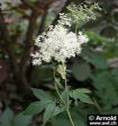Scientific Classification:
|
Other Common Names:
The other common names for the plant meadowsweet are Bridewort,Dropwort,Meadow queen, Meadow-wort, Pride of the Meadow, Lady of the Meadow, Mountain Spirea and Quaker Lady. History



Description
Meadow sweet is one of the best known wild plants which is a hardy villous perennial herbaceous crop, of upright habit, leafed, has repent rhizome and measures between 50 cm and 1.5 m.The root stock is pink and aromatic. It has solid and stiff standards, which are thin and strong and often with red streaks, that carry large, leaves of varying size, dark green on top and with a silvery under surface. The flowers are faintly aromatic, white or cream in colour and display small (1-5 mm), 5-petalled, irregular paniculate cymes. Flowering occurs between mid-summer to early autumn. They form bunches and have a sweet, pervasive scent.Range
Meadow sweet is introduced and naturalized in North America but however now it is a native of most of Europe and western Asia. Although meadowsweet is indigenous to Europe, it thrives without any effort in moist places.Habitat
It thrives best at high altitude and its abundance in meadows, hedges and alongside running water. The herb basically prefers damp places like ditches as well as stream and river banks. Does best in rich, moist soil with partial shade.Cultivation
The herb basically prefers damp places like ditches as well as stream and river banks. Normally, the meadowsweet saplings grow on their own from the seeds. Press seed into surface of flat in spring. Bottom water or mist gently. Waist high bushes with sweet golden inflorescence's (2nd year) that tastes like nectar. Wonderful plant and the leaves in particular are anti-inflammatory and pain relieving. Does best in rich, moist soil with partial shade. However, the herb can also be disseminated through root division. The best time of the year to propagate the herb through root division is autumn or spring. The leaves of the herb and the flower clippings are collected during summer when the flowers are open.Flowering Season
White-flowered meadowsweet has been found in bloom from June to early September..Pests and Diseases
The flower and foliage colour is good and it has shown deer resistance. The main insect pest affecting is the aphid (greenfly), which sucks the sap and weakens the plant. The spraying with insecticide is often recommended but should be done with care to minimize the loss of beneficial insects.Parts Used
  |
The whole herb of the plant meadowsweet is used both for its medicinal and commercial purposes. |
Medicinal Applications


- Meadowsweet is an aromatic, astringent, diuretic, and sub-tonic.
- It is a good remedy in strangury, dropsy, etc., and almost a specific in children's diarrhoea.
- Sweetened with honey, it forms a very pleasant diet-drink, or beverage both for invalids and ordinary use.
- An infusion of the fresh tops produces perspiration, and a decoction of the root, in white wine, was formerly considered a specific in fevers.
- The flowers are alexipharmic and sudorific and good in fevers and all malignant distempers.
- An infusion of the freshly gathered tops of this plant promotes sweating.
- It is a good wound-herb taken inwardly or externally applied.
- A water distilled from the flowers is good for inflammations of the eyes.
- Meadow sweet is used as an anti-rheumatic agent and its astringency makes it a specific for simple diarrhoea.
- It has also earned the tag of the herbal bicarbonate of soda, and is useful for dyspepsia.
- Its diuretic property makes it of use in dropsy and oedema of the limbs.
- Meadowsweet helps in alleviating joint problems and is also used to treat problems like cystitis, inflammation of the urinary bladder, often caused by infection.
- Meadowsweet is blended with other herbs to cure irritable bowel syndrome.
- The tannin property of the plant helps to relax or make the muscles less tense helps in relieving stomach pains and colic disorders.
Commercial Applications
- A natural black dye can be obtained from the roots by using a copper mordant.
Quotes from History
It is one of the fifty ingredients in a drink called 'Save,' mentioned in Chaucer's Knight's Tale, in the fourteenth century being called Medwort, or Meadwort, i.e. the mead or honey-wine herb, and the flowers were often put into wine and beer. It is still incorporated in many herb beers. White-flowered meadowsweet has been found with the cremated remains of three people and at least one animal in a Bronze Age cairn at Fan Foel, Carmarthenshire. Similar finds have also been found inside a Beaker from Ashgrove, Fife and a vessel from North Mains, Strathallan. These could possibly indicate honey-based mead or flavoured ale, or alternatively might suggest the plant being placed on the grave as a scented flower. In 1652, naturalist Nicholas Culpepper had written in his much-valued medical text that "it helps in the speedy recovery from cholic (bile acid) disorders and removes the instability and constant change in the stomach'.
Symbolism and Religious Influence
The name Ulmaria is given in allusion to the resemblance of its leaves to those of the Elm (Ulmus), being much wrinkled on the upper side..." It was also known as Bridewort, because it was strewn in churches for festivals and weddings, often made into bridal garlands. Meadowsweet, water-mint, and vervain were three herbs held most sacred by the Druids.
Folklore and Myths
This sweetly scented flower commonly named "bridal wort" was popular in bridal bouquets, thought to bring love, joy, a beautiful wedding day, and a happy marriage.


